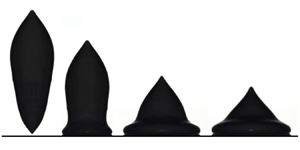Published online by Cambridge University Press: 27 December 2023

The impact of fluid drops on solid substrates is a cardinal fluid dynamics phenomenon intrinsically related to many fields. Although these impacting objects are very often non-spherical and non-Newtonian, previous studies have mainly focused on spherical Newtonian drops. As a result, both shape and rheological effects on the drop-spreading dynamics remain largely unexplored. In the present work we use a mixed approach combining experiments with multiphase three-dimensional numerical simulations to extend the work reported by Luu & Forterre (J. Fluid Mech., vol. 632, 2009, pp. 301–327) by highlighting the fundamental role of shape in the normal impact of viscoplastic drops. Such complex fluids are highly common in various industrial domains and ideally behave either like a rigid body or a shear-rate-dependent liquid, according to the stress solicitation. Spherical, prolate, cylindrical and prismatic drops are considered. The results show that, under negligible capillary effects, the impacting kinetic energy of the drop is dissipated through viscoplastic effects during the spreading process, giving rise to three flow regimes: (i) inertio-viscous, (ii) inertio-plastic, and (iii) mixed inertio-visco-plastic. These regimes are deeply affected by the drop initial aspect ratio, which in turn reveals the possibility of using drop shape to control spreading. The physical mechanisms driving the considered phenomenon are underlined by energy budget analyses and scaling laws. The results are summarised in a two-dimensional diagram linking the drop maximum spreading, minimum height and final shape with different spreading regimes through a single dimensionless parameter, here called the impact number.